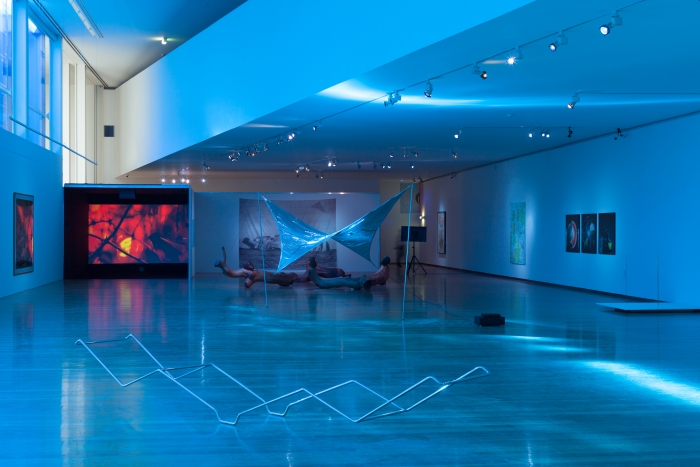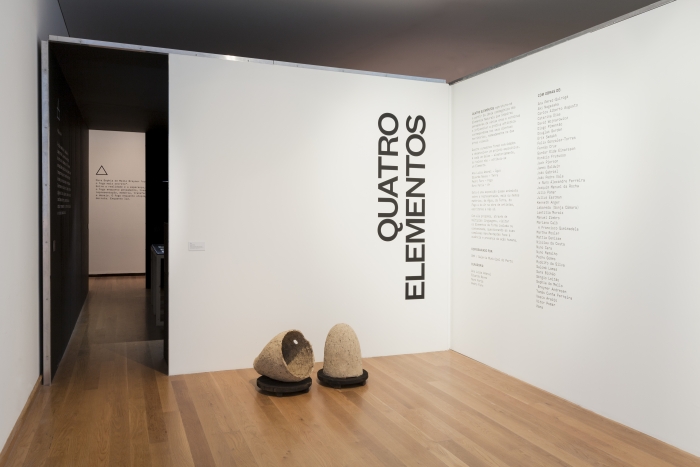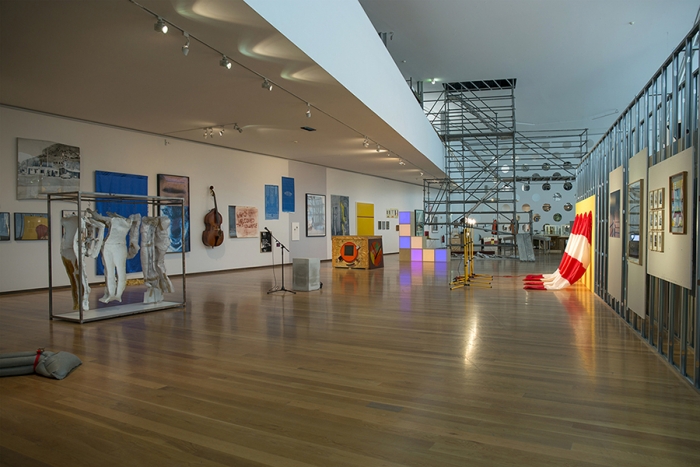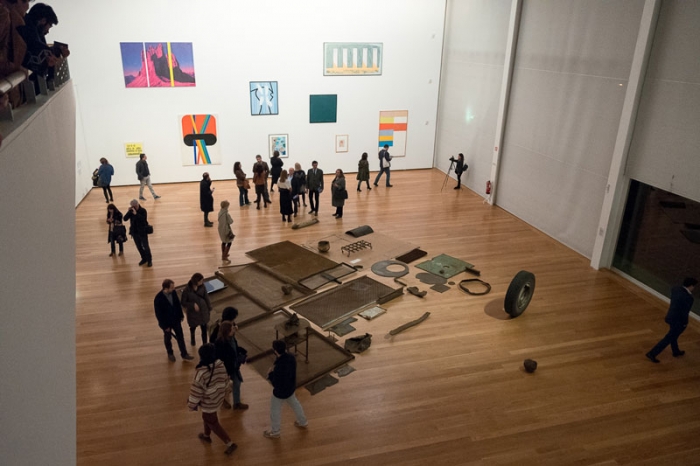Past Exhibitions 2017


09.12 — 18.02.2018
10000 ANOS DEPOIS ENTRE VÉNUS E MARTE
Obras da Coleção António Cachola
Galeria Municipal do Porto presents 10000 anos depois entre Vénus e Marte [10000 years later between Venus and Mars], an exhibition with works from the António Cachola Collection, a leading private collection of contemporary art deposited at the Museum of Contemporary Arts of Elvas (MACE) and the National Museum of Contemporary Art - Museu do Chiado. The collection includes painting, drawing, engraving, sculpture, installation and video with a total of six hundred and fifty artworks by over one hundred Portuguese artists who began exhibiting their works publicly from the 1980 onwards. Continuing its mission to present renowned national collections of contemporary art, with this exhibition Galeria Municipal do Porto also marks the 10th anniversary of the collaboration between MACE / António Cachola Collection.
Curated by João Laia, 10000 anos depois entre Vénus e Marte includes works by artists from different generations, exhibiting for the first time a series of new acquisitions by the Collection. Borrowing its title from the 1978 album by José Cid, the exhibition speculates a dreamlike or hallucinatory territory analysing various realms of daily life by challenging seemingly stable forms of interpreting the real.
Curated by João Laia, 10000 anos depois entre Vénus e Marte includes works by artists from different generations, exhibiting for the first time a series of new acquisitions by the Collection. Borrowing its title from the 1978 album by José Cid, the exhibition speculates a dreamlike or hallucinatory territory analysing various realms of daily life by challenging seemingly stable forms of interpreting the real.


01.09 — 12.11.2017
QUATRO ELEMENTOS
Quatro Elementos (Four Elements) is structured around the cosmogonic idea of the Natural Elements – that has inspired thinkers over the ages and continues to influence contemporary artistic practice in its various different areas, in particular in the visual arts.
Four curators have been invited to develop an exhibition project and each was assigned an Element.
Ana Luísa Amaral - Water, Eduarda Neves - Earth, Nuno Faria - Air, Pedro Faro - Fire
This is a quasi-animistic exhibition about the more or less material representation of the Water, Earth, Fire and Air in the work of artists, writers and other thinkers. This exhibition proposes to visit the Elements, using multiple languages, in an isolated or contaminated manner, questioning their complex manifestations in the absence or presence of human action.
Four curators have been invited to develop an exhibition project and each was assigned an Element.
Ana Luísa Amaral - Water, Eduarda Neves - Earth, Nuno Faria - Air, Pedro Faro - Fire
This is a quasi-animistic exhibition about the more or less material representation of the Water, Earth, Fire and Air in the work of artists, writers and other thinkers. This exhibition proposes to visit the Elements, using multiple languages, in an isolated or contaminated manner, questioning their complex manifestations in the absence or presence of human action.


02.06 — 13.08.2017
THEM OR US!
Um projecto de acção científica social e política
Contemporary art from more than 90 national and international artists compose Them or Us!, an exhibition of political and social science fiction, in which the future intersects with the past, originating the present and which is guided by the maxim of Russian filmmaker Alexander Sokurov, according to whom “in history, we talk about what happened, in art, we talk about what might have happened”.
Curated by Paulo Mendes, the exhibition relates past and future to present a version of the present, based on the multiplicity of works from various artists from different areas and ideas that were just taken as a definition of the present: an era of free movement, abolition of frontiers, and elimination of walls. Social equilibrium is guaranteed by the triumph of a society based on consumerism and speculative wealth, and that this is the end of history.
Them or Us! presents a conceptual machine which uses the idea of the “invader” in its various possible formulations, the creation of fear of “the other” - resulting from invasion of national territories by refugees, terrorists or tourists, and biological invasions via new viruses, contaminations, and contemporary mutations that are altering the original, primitive body.
Curated by Paulo Mendes, the exhibition relates past and future to present a version of the present, based on the multiplicity of works from various artists from different areas and ideas that were just taken as a definition of the present: an era of free movement, abolition of frontiers, and elimination of walls. Social equilibrium is guaranteed by the triumph of a society based on consumerism and speculative wealth, and that this is the end of history.
Them or Us! presents a conceptual machine which uses the idea of the “invader” in its various possible formulations, the creation of fear of “the other” - resulting from invasion of national territories by refugees, terrorists or tourists, and biological invasions via new viruses, contaminations, and contemporary mutations that are altering the original, primitive body.


11.03 — 14.05.2017
QUOTE, UNQUOTE
Entre apropriação e diálogo
Quote, Unquote. Between Appropriation and Dialogue showcases a selection of works from the Fundação EDP collection, patron of the Galeria Municipal since 2015, on the theme of appropriation in contemporary art.
During the time period that defines the collection – from the 1960's to the present day – the exhibition proposes a transversal interpretation of these practices: the direct appropriation of images, texts or other forms of cultural production, the quotation as an element that contributes to the production of meaning, or the conscious dialogue with authors and pre-existing creations. This proposal seeks “not so much to provide a historical reading of the processes of appropriation in the more or less recent history of art, but rather to identify, from the standpoint of some of the critical approaches of recent decades, what may have influenced the work of the artists represented and curatorial choices.
Undertaken as a collaborative curatorship – Gabriela Vaz-Pinheiro and Ana Anacleto – the exhibition is structured around three sub-headings: “Archive and Everyday Life”, “Spatiality and Politics” and “Image and Narrative”, whose aim is to bring together sets of works around elective affinities, thus also proposing intrinsic dialogues.
"As a preliminary remark, we may say that many of these works could drift between these sections. This flexible positioning serves as a parameter for a non-categorical understanding and intends to establish a flow of meaning(s), a kind of rhythm of interpretation in which certain threads are abandoned and then resumed, both between the works present in the exhibition and with others, like an echo of appropriation itself", in Gabriela Vaz Pinheiro’s own words.
During the time period that defines the collection – from the 1960's to the present day – the exhibition proposes a transversal interpretation of these practices: the direct appropriation of images, texts or other forms of cultural production, the quotation as an element that contributes to the production of meaning, or the conscious dialogue with authors and pre-existing creations. This proposal seeks “not so much to provide a historical reading of the processes of appropriation in the more or less recent history of art, but rather to identify, from the standpoint of some of the critical approaches of recent decades, what may have influenced the work of the artists represented and curatorial choices.
Undertaken as a collaborative curatorship – Gabriela Vaz-Pinheiro and Ana Anacleto – the exhibition is structured around three sub-headings: “Archive and Everyday Life”, “Spatiality and Politics” and “Image and Narrative”, whose aim is to bring together sets of works around elective affinities, thus also proposing intrinsic dialogues.
"As a preliminary remark, we may say that many of these works could drift between these sections. This flexible positioning serves as a parameter for a non-categorical understanding and intends to establish a flow of meaning(s), a kind of rhythm of interpretation in which certain threads are abandoned and then resumed, both between the works present in the exhibition and with others, like an echo of appropriation itself", in Gabriela Vaz Pinheiro’s own words.
